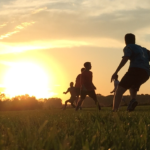Without question, Pokémon is one of the most iconic entertainment franchises ever. In fact, it is the highest-grossing media franchise of all time, coming in at a whopping $76.4 billion in revenue. All franchises come with some form of controversy among media and fans, and although Pokémon has avoided major contention, it has spread misleading information about a topic paramount to biology: evolution.
In the Pokémon video games, anime, and trading card game (TCG), evolution (hereafter Pokémon evolution) involves a single individual undergoing an instantaneous change in form from a lesser form to a greater form. This evolution is often associated with an increase to the Pokémon’s stats, making it better in battle. Usually, a Pokémon’s evolution occurs after it has undergone growth, such as gaining experience from defeating other Pokémon in battle. Because the goal of most Pokémon content is to achieve victory and become a battling champion, it is implied that the Pokémon or its trainer is striving for its evolution.

In the paragraph above, I underlined phrases that correspond to misconceptions of biological evolution. As an evolutionary ecologist, I find it upsetting that my favorite childhood (and adulthood) franchise is spreading these misconceptions. Namely, these misconceptions can lead to a false narrative of evolution and may potentially be dangerous if incorrect ideas of evolution are used to invoke a hierarchy of life. With that said, Pokémon evolution is awesome. Training Pokémon from a cute first-stage Pokémon to a beast, like Swampert or Infernape, and absolutely wrecking house is objectively a good time. It’s inspiring to watch a Pokémon evolve and reach its full potential, and it’s one of the reasons the Pokémon Company has been so successful. However, despite being a wonderful mechanic and storytelling tool, Pokémon evolution is a far cry from biological evolution.
One textbook definition of biological evolution is “a change in allele frequency in a population over time.” This is a jargon-heavy statement, so let’s get into it.
A change in allele frequencies
Before defining alleles, it’s important to recognize that all living things (plants, animals, fungi, bacteria, etc.) have DNA, which is made up of a sequence of nucleotides (A, G, C, and T). All of an organism’s DNA is its genome. Sometimes, but not always, differences between sequences in a certain location in the genome influence how individuals look. For instance, certain DNA sequences may generate different Pokémon colorations. The Pokémon Shellos has two forms: West (pink) and East (blue), probably corresponding to different DNA sequences.
An allele is a particular variant of the sequence location in the genome. The sequences AGTA and AGCA are two different alleles, so long as they correspond to the same genomic location. Lastly, and VERY importantly, when an individual’s genome is first formed, that genome is set forever. That is, a single individual’s alleles never change, they’re stuck with the same alleles across their genome for their whole life. As such, if a Shellos has the allele for West coloration, it will always be pink and can never change forms.
A “change” in allele frequencies is when the proportion of an allele in a population varies. For example, if 750 Shellos in a population of 1000 have the West allele and the other 250 have the East allele, we’d say the West allele has a frequency of 0.75 and East, 0.25. A switch to West: 0.6 and East: 0.4 would represent a change in allele frequencies. That is, the number of Shellos with the Western pink coloration would change from 75% to 60%.


Pokémon evolution is accompanied by an immediate change in form. As I outlined above, biological evolution is a change in allele frequencies, which may or may not correspond to a change in form. Above, I outlined how changes to allele frequencies can generate change in form for Shellos, but it’s worth noting that Shellos likely has many variable alleles that do absolutely nothing to change its form (all organisms have lots of DNA that doesn’t do much). Strike one against Pokémon evolution: biological evolution does not mean a change in form. Frankly, physical change associated with Pokémon evolution is more consistent with metamorphosis (like when a caterpillar transforms into a butterfly) than any sort of biological evolution, which happens over generations.
In a population
We can define a population as a group of individuals who interbreed. If a species, let’s say, Vivillon, existed on two islands, and the Vivillon on each island only mated with other Vivillon on that same island, each island would constitute a different population of Vivillon. Notably, allele frequencies are calculated at the population level, so the two islands may have different frequencies of an allele that give Vivillon pink wings instead of green wings. That’s strike two. If you recall, Pokémon evolution happens in a single individual, while biological evolution requires change of allele frequencies in a population of individuals.


Over time
As I hinted at earlier, evolutionary change is not instantaneous. For sexually reproducing organisms, alleles are mostly transmitted from parents to offspring. Because the alleles of single individuals don’t change, the only way for allele frequencies to change in a population is via births or deaths, which generally take time to pile up and cause substantial change. Strike three against Pokémon: biological evolution takes time, and usually occurs via incremental change in allele frequencies of a population. Pokémon evolve in mere seconds.
The fourth strike: there is no drive to evolve
Above, I noted that in the Pokémon universe, Pokémon and trainer work hard to make the Pokémon evolve. When the Pokémon does evolve, it changes from a “lesser” to a “greater” form. This is eons from the truth of biological evolution, but it is easy to see why evolution by natural selection may generate these misconceptions.
Evolution by natural selection makes a population more adapted to its environment, but this doesn’t mean the population is “greater.” It just means the population will grow faster than it did before. Evolution by natural selection occurs when individuals with certain alleles are more likely to survive and reproduce than those without the alleles. Over time, if a certain allele consistently generates the highest survival rates in a population, that allele will increase in frequency since more survive to reproduce in subsequent generations vs. other alleles. Notably, natural selection occurs in response to an environment; populations aren’t “striving to adapt” to the future.
A classic example of evolution by natural selection is the case of peppered moths of Manchester. These moths perch on trees that are covered in lichen, making the trees white. Because these moths are the prey of birds, which are sight predators, it was beneficial for moths in Manchester in the 1840s to be white to blend in with the lichen on trees. Still, there were a few individuals who were darker colored and had poor camouflage on the lichen trees. Notably, this coloration had a genetic basis (different alleles determined white vs black coloration).
During the industrial revolution, tree trunks in Manchester became coated with soot, turning their trunks from white to black. The rare, black moths now had solid camouflage, while the white moths stuck out like sore thumbs. Consequently, white moths were now consumed by birds at much higher rates than black moths, meaning black moths survived and passed their alleles on to offspring at a much higher rate than white moths. Over time, the black moths became the dominant variant; the population adapted in response to the new environment. Many years later, when the smokestacks stopped pumping out soot and the tree trunks returned to a lichen-covered white, the white moths became the dominant variant in the population again.


Biological evolution in the Pokémon games
In Pokémon’s 7th generation of media (Pokémon Sun and Moon), they introduced a new type of Pokémon: regional variants. These are Pokémon that are the same species as their base Pokémon from a different region, but because they are in a different region with a different environment, they have different forms and types. To me, this sounded like the outcome of evolution by natural selection, and this is how the Pokémon company intended it. In the Pokémon Sun and Moon games, which were the first to introduce regional variants, a cousin of Professor Oak, Samson Oak, is quoted saying, “Yes, regional variants… They arise when the influences of a particular region cause a Pokémon’s physical aspect and even type to change.” That’s evolution by natural selection.
My favorite example of regional adaptation in Pokémon is that of Weezing, whose evolution parallels that of peppered moths. The 8th generation of Pokémon introduced us to the Galar region, which was based on industrial Great Britain. Outside of the Galar region, Weezings feed on poisonous gases from rotting items in trash (methane). In the Galar region, Weezings feed (and look) very different. During the Galarian industrial revolution, some Weezings switched their food source from methane to fumes produced by factories (mainly carbon dioxide). Weezings that could consume the more abundant carbon dioxide survived and reproduced at higher rates than regular Weezings, leading to adaptation to consume rampant air pollution in the Galar region.


Pokémon has a history of questionable definitions of evolution, but despite this history, the company has done a wonderful job introducing regional variants which embody the outcome of adaptation to novel environments. Hopefully, next time you enjoy a Pokémon game, watch the anime, or play the trading card game, you can take these evolutionary concepts with you to understand a little more about how biological evolution has shaped Pokémon diversity.
About the Author
Riley is a PhD student in the Department of Plant Biology. He received his B.A. in honors biology from Gustavus Adolphus College in Saint Peter, MN. Riley's research aims to understand how habitat fragmentation and climate change influence plant conservation through effects on the ecology and evolution of populations. Currently, his research highlights how climate change is affecting stress-adapted plant populations on Georgia's granitic outcrops. If he's not in the field doing his research, you'll find Riley watching marble races.
- Riley Thoenhttps://athensscienceobserver.com/author/riley-thoen/November 25, 2024
- Riley Thoenhttps://athensscienceobserver.com/author/riley-thoen/
- Riley Thoenhttps://athensscienceobserver.com/author/riley-thoen/








